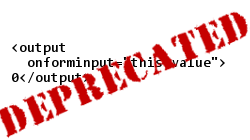 Do you want the state of a web page to be rendered by both the client and the server side? Is having the state of a JavaScript rendered web page to be controlled by the page’s query string important to you? Is important for you to ensure that your page’s state can be shared correctly via email and social media? If you want all of this without being tied into any specific framework (e.g. React, jQuery, Angular, etc) and done using progressive-enhancement, read on.
Do you want the state of a web page to be rendered by both the client and the server side? Is having the state of a JavaScript rendered web page to be controlled by the page’s query string important to you? Is important for you to ensure that your page’s state can be shared correctly via email and social media? If you want all of this without being tied into any specific framework (e.g. React, jQuery, Angular, etc) and done using progressive-enhancement, read on.
Entries Tagged as 'JavaScript'
Making Framework Agnostic Isomorphic Web Applications with Query Strings and HTML5 pushState
Tags: Events · Events · forms · HTML5 · pushState
Animating Circular Paths Using CSS3 Animations.
 For the longest time I assumed that one couldn’t use CSS Transitions or animations to move DOM objects in anything but a straight path. Sure, a developer could use multiple keyframes to create a list of straight paths to simulate a curve, but I didn’t think one could just define a curve with just two keyframes. I was wrong. If you are coding for a modern web browser, then this is very doable!. This article will show you how it’s done in modern browsers, the math involved, and what to do with older versions of IE that don’t support CSS3 Animations.
For the longest time I assumed that one couldn’t use CSS Transitions or animations to move DOM objects in anything but a straight path. Sure, a developer could use multiple keyframes to create a list of straight paths to simulate a curve, but I didn’t think one could just define a curve with just two keyframes. I was wrong. If you are coding for a modern web browser, then this is very doable!. This article will show you how it’s done in modern browsers, the math involved, and what to do with older versions of IE that don’t support CSS3 Animations.
Tags: animation · animation · CSS · CSS3 · JavaScript · math · transform · transition
Cross-Browser Animated Image Masking (Even in IE) Using polyClip.js
 I first created polyClip.js so I could combine the lossy compression algorithm of JPEGs with the ability to have a transparent area that PNGs allow. The result works well in all browsers, but can polyClip.js be fast enough to change the clipping area on-the-fly and even animate it at reasonably fast speeds with CSS3-style transformations on the clipping areas. The answer is a resounding yes and it is really fast even in older IE as well. This article will discuss in doing this with polyClip and a related library, Silk.js to do battery friendly and CPU efficient HTML5 animations.
I first created polyClip.js so I could combine the lossy compression algorithm of JPEGs with the ability to have a transparent area that PNGs allow. The result works well in all browsers, but can polyClip.js be fast enough to change the clipping area on-the-fly and even animate it at reasonably fast speeds with CSS3-style transformations on the clipping areas. The answer is a resounding yes and it is really fast even in older IE as well. This article will discuss in doing this with polyClip and a related library, Silk.js to do battery friendly and CPU efficient HTML5 animations.
Tags: animation · canvas · HTML5 · Images · JavaScript · jQuery · requestAnimationFrame · transform
Cross Browser GPU Acceleration and requestAnimationFrame in Depth
 Animations made with
Animations made with requestAnimationFrame appear less jumpy and stuttery than those using setTimeout or jQuery.animate by ensuring that animation frames are generated at the most optimal times according to the CPU load, what the browser is doing, what the graphics card is doing, etc. Recently, I researched a bit about how it works, how different browsers behave with it, and how well browsers are at animating both Canvas and SVG. This article will be a brain dump of all I have learned so far. Some of what I discovered may surprise you.
Tags: canvas · HTML · HTML5 · jQuery · Polyfills · SVG · Uncategorized · VML · XML
Cross Browser HTML5 Progress Bars In Depth
 As a web application developer, progress bars are great when you want to show the user that some action is happening, especially when it can take a long time. Creating them is easy with the HTML5
As a web application developer, progress bars are great when you want to show the user that some action is happening, especially when it can take a long time. Creating them is easy with the HTML5 <progress> tag. This article will discuss how this tag is rendered by default in all operating systems and browsers and how to style the progress tag with CSS, even in browsers that don’t officially support the it. It will also show some interesting examples using advanced CSS3 techniques.
Tags: CSS3 · Forms · gradients · HTML · HTML5 · Polyfills · progress
Clipping JPEG Images Into Non-Rectangular Polygons Using polyClip.js
 Up until now, if a developer needed to clip an image in a non-rectangular shape, it was necessary to save the image as a PNG with an alpha channel. If the image is a photograph, the file-size balloons up to unacceptable levels. My new library, polyClip.js, allows developers to clip these images using photograph friendly JPEGs instead. This article guides you step by step on how to use it yourself.
Up until now, if a developer needed to clip an image in a non-rectangular shape, it was necessary to save the image as a PNG with an alpha channel. If the image is a photograph, the file-size balloons up to unacceptable levels. My new library, polyClip.js, allows developers to clip these images using photograph friendly JPEGs instead. This article guides you step by step on how to use it yourself.
Tags: canvas · HTML5 · Images · JavaScript · jQuery · Uncategorized · VML
Full CSS3 Text-Shadows — Even In IE
 While researching the possibilities of using text-shadows in IE, I noticed that there wasn’t any silver bullet that produced multiple CSS3-like text-shadows in IE. However, combining my cssSandpaper script with a refactored version of a text-shadowing script by Kazumasa Hasegawa, we can now have IE text-shadow goodness.
While researching the possibilities of using text-shadows in IE, I noticed that there wasn’t any silver bullet that produced multiple CSS3-like text-shadows in IE. However, combining my cssSandpaper script with a refactored version of a text-shadowing script by Kazumasa Hasegawa, we can now have IE text-shadow goodness.
Tags: ClearType · CSS · CSS3 · IE Visual Filters · JavaScript · Polyfills · text-shadow
Fixing oninput in IE Using html5Widgets
 Even though
Even though onforminput is deprecated, oninput will allow developers to do dynamic calculations on forms with little JavaScript knowledge. Unfortunately, it doesn’t work in IE8 and lower, and there are some small bugs in IE9’s implementation when trying to delete characters inside a form field. So I implemented a fix for these issues with an update to my cross-browser HTML5 Forms polyfill, html5Widgets.
Tags: Events · Events · Forms · HTML · HTML5 · JavaScript · Polyfills · Uncategorized
Is onforminput Deprecated in HTML5 Forms? (And Why Should I Care Anyways?)
 The
The onforminput event has been stripped out of HTML5, and it makes me sad. This article will show examples of how it works, how you can use it today in browsers that don’t support it, and hopefully will also present a good case as to why it should be put back into the HTML5 specification. Should something this useful and easy-to-use be abandoned?
Tags: Events · Events · Forms · HTML · HTML5 · Polyfills
Cross Browser HTML5 Ruby Annotations Using CSS
 Ruby Characters, although used originally to help people read complicated Chinese and Japanese characters, can also be used to annotate all types of information to written text. This article shows how you can use it in browsers that support it, but also in ones that don’t using a simple stylesheet.
Ruby Characters, although used originally to help people read complicated Chinese and Japanese characters, can also be used to annotate all types of information to written text. This article shows how you can use it in browsers that support it, but also in ones that don’t using a simple stylesheet.
Tags: CSS · CSS3 · HTML · HTML5 · Internationalization · Polyfills · Ruby
 @zoltandulac
@zoltandulac
 @zoltandulac
@zoltandulac Zoltan Hawryluk
Zoltan Hawryluk